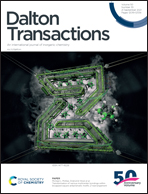Two In-based organic–inorganic hybrid compounds with reversible phase transition derived from the order–disorder changes of cations or anions†
Abstract
Solid-state phase transition materials have received extraordinary interest due to their rich physical properties, such as thermal, dielectric, and ferroelectric properties. Here, two In-based organic–inorganic hybrid compounds, (C6H5CH2CH2NH3)3[InBr5(H2O)] (1) and [(C3H7)4N][InCl4] (2), both display reversible phase transition and dielectric response. Differential scanning calorimetry measurements indicate that the phase transition temperatures (Tc) of 1 and 2 are 167 K and 351 K, respectively. Moreover, structural analyses disclose that the phase transition of 1 can be attributed to the order–disorder changes of phenethylammonium organic cations whereas the phase transition of 2 is caused by the order–disorder changes of [InCl4]− anions. The phase transitions of In-based organic–inorganic hybrid compounds can be driven by the order–disorder changes of cations or anions. Therefore, the system of In-based organic–inorganic hybrid compounds is very suitable for exploring organic–inorganic hybrid phase transition materials.



 Please wait while we load your content...
Please wait while we load your content...